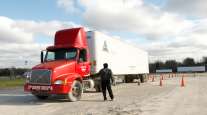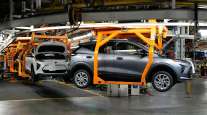Editorial: A Next Generation Is Coming
President Obama took some time to talk about trucks and trucking last week, and while standing among some Class 8s, he observed:
“Trucks like these are responsible for about 20% of our on-road fuel consumption, and because they haul about 70% of all domestic freight — 70% of the stuff we use, everything from flat-screen TVs to diapers to produce to you-name-it — every mile that we gain in fuel efficiency is worth thousands of dollars of savings every year.”
We’re pleased to see the president knows the industry has been busy.
As we note in our story, he then asked trucking and its major equipment suppliers to get even busier, hauling not just goods and products but a big part of the national campaign to better air quality. The president told two major federal agencies to write another regulation building on the one from 2011 that would further tighten carbon dioxide emissions from heavy- and medium-duty trucks while simultaneously improving fuel economy.
American Trucking Associations President Bill Graves said after the Obama address, “We stood shoulder-to-shoulder with the president and his administration in 2011 when the historic first fuel-efficiency standards were set for heavy-duty vehicles. As we begin this new round of standards, ATA hopes the administration will set forth a path that is both based on the best science and research available and economically achievable.”
Trucking is proud to contribute to cleaner air for all, but we hope federal officials are taking note of what’s going on: About every three years a new generation of truck is born.
There were mandates related to nitrogen oxides and soot in 2002, 2007 and 2010. Each generation needed new technology. Greenhouse-gas rules kicked in this year, and a follow-up for 2017 is already on the books.
Obama’s latest challenge is supposed to produce a final rule in March 2016 with an effective date of 2020 being probable. From 2002 to 2020, that means six generations of technology.
We’d appreciate it if these changes could be paid for with an 18-month return on investment, meaning a year-and-a-half’s worth of fuel savings covers the incremental technology.
And by the way, does the U.S. Treasury really have to charge a 12% federal excise tax on all of this more costly new equipment? This is an appropriate time to renew trucking’s appeal to fund infrastructure projects with motor fuels taxes, not an FET.
Welcome to the next new generation.




